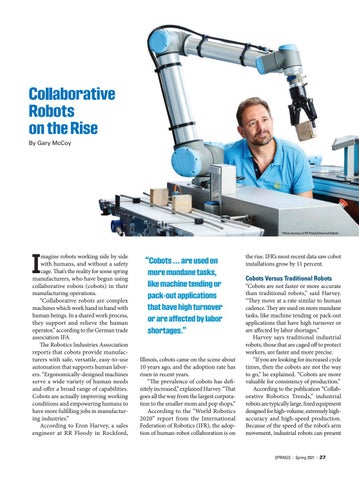Collaborative Robots on the Rise By Gary McCoy
Photo courtesy of RR Floody/Universal Robots
I
magine robots working side by side with humans, and without a safety cage. That’s the reality for some spring manufacturers, who have begun using collaborative robots (cobots) in their manufacturing operations. “Collaborative robots are complex machines which work hand in hand with human beings. In a shared work process, they support and relieve the human operator,’’ according to the German trade association IFA. The Robotics Industries Association reports that cobots provide manufacturers with safe, versatile, easy-to-use automation that supports human laborers. “Ergonomically-designed machines serve a wide variety of human needs and offer a broad range of capabilities. Cobots are actually improving working conditions and empowering humans to have more fulfilling jobs in manufacturing industries.” According to Eron Harvey, a sales engineer at RR Floody in Rockford,
“Cobots ... are used on more mundane tasks, like machine tending or pack-out applications that have high turnover or are affected by labor shortages.” Illinois, cobots came on the scene about 10 years ago, and the adoption rate has risen in recent years. “The prevalence of cobots has definitely increased,” explained Harvey. “That goes all the way from the largest corporation to the smaller mom and pop shops.” According to the “World Robotics 2020” report from the International Federation of Robotics (IFR), the adoption of human-robot collaboration is on
the rise. IFR’s most recent data saw cobot installations grow by 11 percent.
Cobots Versus Traditional Robots
“Cobots are not faster or more accurate than traditional robots,” said Harvey. “They move at a rate similar to human cadence. They are used on more mundane tasks, like machine tending or pack-out applications that have high turnover or are affected by labor shortages.” Harvey says traditional industrial robots, those that are caged off to protect workers, are faster and more precise. “If you are looking for increased cycle times, then the cobots are not the way to go,” he explained. “Cobots are more valuable for consistency of production.” According to the publication “Collaborative Robotics Trends,” industrial robots are typically large, fixed equipment designed for high-volume, extremely highaccuracy and high-speed production. Because of the speed of the robot’s arm movement, industrial robots can present
SPRINGS / Spring 2021 / 27
















